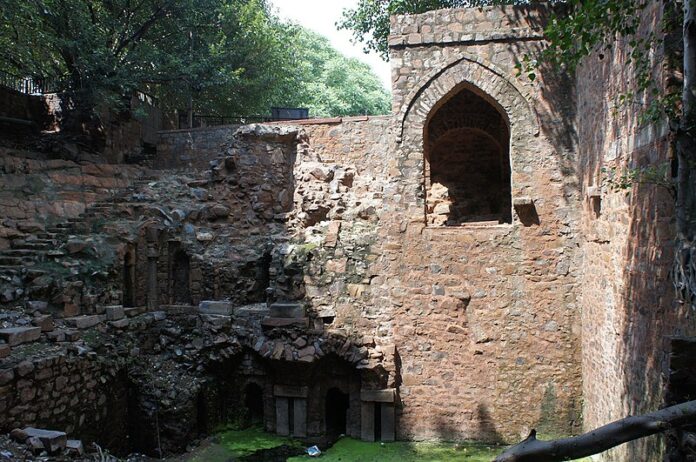Delhi Ridge’s Boundary Wall Redesigned to Enhance Wildlife Movement
The forest and wildlife department of Delhi has recently unveiled plans to revamp the boundary wall surrounding the Delhi Ridge. The decision was prompted by the discovery of breaches that have allowed intruders to enter and dump waste in the ridge areas. The officials involved in the matter disclosed that the planning process began in December of last year, and a tender will soon be issued to initiate the construction work in phases.
The existing boundary wall, which spans a height of three meters, has suffered multiple breaks, enabling unauthorized individuals to trespass into the ridge. Furthermore, instances of waste disposal within the ridge have been observed. To address these concerns, the new design aims to not only fortify the existing walls but also create passages for wildlife to move freely. The redesigned wall will feature barbed wires atop and small openings at its base, facilitating the unobstructed movement of reptiles and other animals. In addition, the wall will bear a distinctive logo stating “Department of Forest and Wildlife,” ensuring its identification and differentiation from similar stone walls found in the southern ridge region where farmhouses are prevalent.
The implementation of the new design is part of a comprehensive plan that also involves extending boundary protection to recently acquired forest land and areas cleared of encroachments. Non-ridge sections such as city forests and the Yamuna floodplains will utilize wire mesh fencing instead of stone walls to safeguard the boundaries. The integration of these measures aims to enhance the protection of these ecologically significant areas.
To address the issue of outdated design, a notice released by the department on May 15 outlined the approved modifications. The revised design involves embossing the reinforced cement concrete (RCC) pillars with the “Department of Forest and Wildlife” logo, interspersed with coarse rubble masonry. Small openings will be incorporated at the base to ensure unimpeded movement for reptiles and other wildlife. However, non-ridge areas will utilize RCC pillars with a height of three meters, with a distance of around three meters between each pillar, supplemented by wire mesh fencing. In some areas, barbed wire may be deployed on the slanted portions of the pillars to provide additional security.
The exact cost estimate and timeline for completion will be determined following the issuance of the tender.
The Delhi Ridge, an extension of the Aravalli Range, is divided into four distinct zones: the northern ridge, central ridge, south central ridge, and southern ridge. Spanning a vast area of nearly 7,800 hectares, the ridge plays a vital role in maintaining the ecological balance of the region.
In recent years, concerns have been raised regarding the improper disposal of waste in various parts of the ridge, particularly the central ridge. Citizen-led initiatives such as “There is No Earth B” have been actively involved in cleaning drives to address this issue. Despite their efforts and a complaint filed with the Central Pollution Control Board, waste dumping and burning persist due to the broken sections of the boundary wall.
There is No Earth B
Bhawna Tanwar, a campaigner from “There is No Earth B,” expressed her disappointment with the lack of remedial action taken thus far. She emphasized the need for prompt repairs to deter further waste dumping in the area.
The redesigned boundary wall surrounding the Delhi Ridge serves as a crucial step toward preserving the natural habitat and enabling the free movement of wildlife. By addressing breaches and incorporating wildlife-friendly features, the forest and wildlife department aims to protect the ridge from unauthorized access and promote a harmonious coexistence between humans and nature.
The decision to redesign the boundary wall around Delhi Ridge has generated mixed reactions among the public. While some view it as a necessary measure to address the issues of unauthorized access and waste dumping, others express concerns about the potential impact on the aesthetics and integrity of the ridge.
Proponents of the new design argue that the breaches in the current wall have posed significant challenges in terms of security and conservation. By allowing intruders to enter and exit the ridge, these openings have not only compromised the safety of the area but also facilitated the unlawful disposal of waste. The redesigned wall, with its reinforced structure and the inclusion of barbed wires on top, aims to deter trespassers and ensure better protection for the ridge.
Additionally, the incorporation of small passages at the base of the wall to facilitate the movement of reptiles and other animals has been hailed as a positive step toward preserving the biodiversity of the ridge. Wildlife enthusiasts and conservationists believe that providing these animals with unobstructed pathways is essential for maintaining the ecological balance and supporting the natural habitats within the Delhi ridge.
Moreover, the decision to mark the redesigned wall with the “Department of Forest and Wildlife” logo is seen as a practical solution to address confusion between private and public land in the southern ridge, where farmhouses with similar walls are present. This distinct marking will help clearly identify the boundary and eliminate any ambiguity, ensuring that encroachments are minimized and the ridge’s integrity is maintained.
However, there are those who voice concerns about the impact of the new design on the visual appeal and natural aesthetics of the ridge. Some argue that the introduction of barbed wires and the inclusion of a logo might disrupt the scenic beauty of the area, detracting from its charm as a natural heritage site. These individuals emphasise the need for a balanced approach that considers both the functional aspects of the wall and the preservation of the ridge’s intrinsic beauty of Delhi.
Furthermore, the decision to use wire mesh fencing instead of stone walls in non-ridge areas, such as city forests and the Yamuna floodplains, has raised questions about the effectiveness of this alternative in providing adequate protection. Critics argue that wire mesh fencing may be less durable and more susceptible to damage, potentially compromising the security and conservation efforts in these areas.
Despite the differing viewpoints, it is evident that the forest and wildlife department’s intention to address the breaches and enhance the protection of the Delhi Ridge is well-intentioned. The redesign of the boundary wall aims to strike a balance between safeguarding the ridge from unauthorized access and ensuring the free movement of wildlife. By implementing these measures, the authorities hope to create a harmonious coexistence between humans and nature, where the ridge can continue to thrive as an ecological sanctuary in delhi.
The upcoming tender for the construction work will provide a clearer understanding of the project’s timeline and cost, which will further inform public discussions. It is crucial that stakeholders actively engage in dialogue and ensure that the concerns raised are addressed, while also recognizing the need for effective measures to protect the ridge’s natural resources.
Ultimately, the success of the redesigned boundary wall will depend on its ability to achieve its intended goals—strengthening security, preventing waste dumping, and facilitating wildlife movement—while striking a balance with the ridge’s ecological and aesthetic aspects. By addressing these concerns collectively, the authorities can ensure the long-term preservation of Delhi Ridge as a cherished natural treasure for future generations to enjoy.
In light of the plans to redesign the boundary wall surrounding Delhi Ridge, the forest and wildlife department has acknowledged the importance of incorporating feedback from various stakeholders of Delhi. Recognizing the concerns raised by environmentalists and nature enthusiasts, the department is committed to striking a balance between functional requirements and the preservation of the ridge’s natural beauty.
To address apprehensions about the potential impact on the visual appeal of the ridge, the department has expressed a willingness to explore design alternatives that blend seamlessly with the natural surroundings. They understand the significance of maintaining the unique charm and aesthetics of the ridge, which has long been admired for its scenic landscapes and ecological diversity.
In addition to the visual aspect, the department is also keen on ensuring the effectiveness and durability of the proposed wire mesh fencing in non-ridge areas. They are open to conducting thorough evaluations and seeking expert opinions to ensure that the chosen materials and construction methods provide robust protection against encroachments while standing the test of time.
Public engagement and participation will be crucial throughout the process. The department plans to hold consultations and gather inputs from environmental organizations, citizen-led initiatives, and local communities who have a vested interest in the conservation of the ridge. By incorporating diverse perspectives, the authorities can make informed decisions that address concerns and uphold the core principles of environmental sustainability in delhi.
Furthermore, the department aims to create awareness and educate the public about the importance of preserving the ridge’s ecological balance. Initiatives such as educational programs, nature walks, and community outreach campaigns can foster a sense of ownership and responsibility among citizens, encouraging them to actively participate in the conservation efforts.
It is worth noting that the redesign of the boundary wall is just one aspect of a larger conservation plan for Delhi Ridge. The authorities are also focused on tackling waste management issues, preventing encroachments, and promoting sustainable practices within and around the ridge. These efforts will require a multi-pronged approach, involving collaboration between government agencies, local communities, and environmental organisations of delhi.
As the project progresses, it will be essential for the forest and wildlife department to maintain transparency and provide regular updates to the public. Clear communication channels will help dispel any misinformation or misconceptions surrounding the redesign process, fostering trust and understanding among stakeholders of Delhi .
Ultimately, the success of the new boundary wall design will be measured by its ability to strike a harmonious balance between protecting the ridge’s ecological integrity and accommodating the needs of various stakeholders. With careful planning, inclusive decision-making, and a commitment to environmental sustainability, Delhi can pave the way for a model of responsible conservation that sets a positive precedent for other regions facing similar challenges faced delhi
By working together, Delhi can ensure that their beloved Delhi Ridge remains a thriving ecosystem, a haven for wildlife, and a source of pride for future generations. With the right approach, the redesigned boundary wall can become a symbol of the city’s commitment to preserving its natural heritage while ensuring the well-being of its residents and the environment they share.


